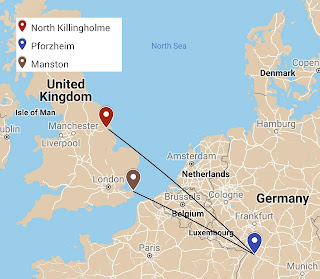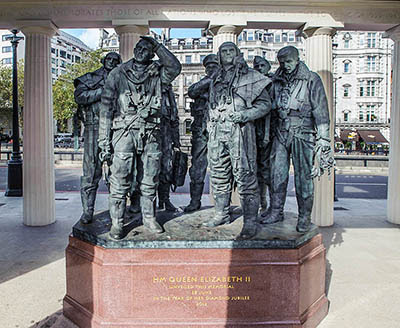February 23, 1945 - PFORZHEIM
From the Operations Record Book:
27 aircraft and crews were called for to attack PFORZHEIM and took off at approx. 16.00 hrs without incident. Weather at take-off was 10/10 low cloud down to 600 ft, but broke up over the continent and the target was quite clear, with some “dangerous moonlight.” The markers were accurately placed and the bombing was correspondingly concentrated and the attack has every appearance of being a highly successful one, fires could still be seen 150 miles away on the homeward journey. Very slight light flak was encountered over the target but night fighters were much in evidence. “C” (F/O Grundy) failed to return from this operation. F/O RD Harris in [NF998] despite a damaged port outer engine which caught fire over the target and severed tube caused by incendiaries, limped back and landed at Manston. One of the crew was injured but not seriously.
---
---
LIVE OPERATION: PFORZHEIM
CREW:
• F/O Robert Douglas Harris (Pilot) RCAF• SGT Kenneth John Boucher Smith (Flight Engineer) RAF
• F/SGT David Johnston Yemen (Navigator) RCAF
• F/O Gordon James Nicol (Air Bomber) RCAF
• SGT Gerard Patrick Kelleher (Wireless Operator) RAF
• SGT Douglas James Hicks (Rear Air Gunner) RCAF
• SGT Melvin Toman Ditson (Mid Upper Air Gunner) RCAF
AIRCRAFT:
LANCASTER NF998 “D-Dog” (BQ-D)FLIGHT NOTES:
On the evening of February 23, the crew took off from North Killingholme at 15.58 in the direction of Pforzheim, Germany. At 20.08, the crew reached their target and released their bomb load from 8,000 ft. Within seconds, the crew found themselves underneath another Lancaster’s bomb load and were struck by approximately sixty 4 lb incendiary bombs. According to the Station Narrative, one of the incendiaries broke through the upper turret, breaking it in two and fracturing Ditson’s shoulder. Another incendiary just missed Harris, breaking the oxygen bottle next to the pilot’s seat. Another embedded itself in a heating pipe in the fuselage, six were embedded in the tail plane and elevator, three more embedded in the port wing and another one or two in the starboard wing.Smith and Nicol took turns assisting Harris in holding the right rudder pedal and the crew managed to crash-land at RAF Manston. “D-Dog” was classified as ‘E’ - beyond repair and written off completely.
RAF Manston, along with RAF Carnaby and RAF Woodbridge, were designated as Bomber Command’s South coast emergency landing grounds, the aim being to keep active airfields clear of disabled aircraft.
After receiving initial treatment at Manston’s S.S.Q. (station sick quarters), Ditson would find himself at the No. 16 Canadian General Hospital in Marston Green recovering from a double fracture of the right scapula. This will be Ditson’s last flight with his crew.
Hicks described the experience in May 1998, posted on the 550 Squadron website:
February 23, 1945, this is our fifth trip. We as a crew are becoming more experienced. We still have not been assigned our own aircraft. For this trip we are again “borrowing” an aircraft. “D” for dog will be our home tonight on this trip which will be in excess of eight hours.
Tonight the target is Pforzheim.
Many of our trips have been eight to nine hours long and on one occasion we missed the target completely and had to return the next night to do final justice for our failed efforts.
This would be an interesting trip as we were taking off in daylight at 1600. We would be flying at a lower than normal altitude across France towards our target in Germany. This would be exciting to me as we would be flying over France at around 2000 feet in daylight. The French countryside would flash by underneath my turret and I would have a spectacular view of France. When darkness came we would then climb to our previously assigned altitude of 20,000 feet.
Nearly all of the bombing raids that the Royal Air Force made were at night. We would normally be airborne around 2000 hours and arrive at the target area around midnight. Tonight would put us over the target around 2100 hours.
The trip was uneventful up to this point and we arrived at the target area, Pforzheim, on time. Our assigned altitude was 20,000 feet. Many a Lancaster would find that it could just maintain this altitude. The Lancaster usually peaked out at 24,000 feet. As we approached the target area, the glow in the sky from fires turned the target into virtual daylight, usually, the fires were started by the U.S. Airforce, who would have bombed during daylight hours and by now were now raging furiously. This would transform the target and the sky around it into stage lit setting with a variety of unimaginable colors.
As we lined up for the bombing run we could hear the voice of what was called the Master Bomber. The Master Bomber was usually a Mosquito, a twin engine bomber that had incredible performance figures and an unequalled history of many unusual sorties. The calm voice and pronounced English accent of the pilot had a somewhat re-assuring tone to it and one could almost picture the pilot describing a polo match as he issued instructions, “Bomb is on the red Tis”, “good show men”, “we are right on target”, “move up a bit from the red” and “jolly good show.”
Bomb doors were opened and we lined up for the final minute of the bombing run. All of a sudden the aircraft lurched violently to the left and started a downward spiral, sparks and flames were visible streaming past my turret and my intercom went dead, the hydraulic power to my turret was cut off and it was necessary to crank the turret by hand.
 |
| An aerial view of Pforzheim, a Lancaster visible at top-left. Source: www.argunners.com |
Suddenly the aircraft seemed to right itself and appeared to level off. I was confident that it was now back under control of the pilot and continued cranking the turret by hand and maintain surveillance. Although, we, as a crew were not aware of what happened at the time we found out later that we had been hit by the bomb load of another Lancaster that was flying above us. It was carrying a load of three pound incendiaries.
It was not unusual for bomber crews to fly above what was the assigned altitude, the reasons being that they would be above the enemy flak and would decrease their chances of encountering enemy fighter aircraft. This practice was never officially endorsed. A Lancaster carrying incendiaries would have little trouble gaining excess altitude due to the lower weight of this particular bomb load. Our pilot was one who went by the book and we would always follow the assigned altitudes we were given at briefing. Secretly there were times when I wished he would cut a corner or two.
One of my crew members came back to see if I was okay and through the noise of the aircraft and sign language I surmised that all was under control and we were now heading for home.
Up front, in the cockpit, the pilot found that he had a fire warning from No. 1 engine and feathered it. This was the engine that supplied the hydraulic power for my turret. With the engine feathered the aircraft wanted to turn to the left, with help from the engineer they were able to lash the rudder pedals to the full right position. The pilot was not aware at the time that the left rudder control rod had been burned through, just as if an acetylene torch had been used, by one of the falling incendiaries. This added to the difficulties of keeping the aircraft flying in a straight line. It took virtually all of their strength on the rudder pedals to keep the aircraft flying straight. They rigged up a length of rope and were able to put on full right rudder to keep us flying in a straight direction. I should point out that the Lancaster is a one pilot airplane. An emergency jump seat can be dropped down for the engineer to assist in handling the controls. During this turn of events the Mid-upper gunner had been struck by one of the incendiaries while in his turret. This three pound incendiary bomb struck the plexi-glass cover of the turret shattering it and then it bounced off his shoulder fracturing it. He was now laying on the floor in the main fuselage and suffering considerable pain.
Back in my end of the aircraft I could see the two main horizontal tailplane assemblies. I counted six holes in the left side and another on the right side. At this time I was still ignorant of what had happened.
We were now almost flying normally and heading for home. It was decided that we would head for one of the emergency airdromes designed for situations such as ours. The main airport in the south of England was Manston. Now the navigator steered us to the awaiting airport. The sky was heavily overcast and navigation had to be right on. As we approached the area of the airport the clouds spread open as if by magic and formed a perfect circle over the Manston airport. It was a piece of cake to locate the airdrome and prepare for landing.
All of the crew took emergency landing positions which were in the main fuselage of the aircraft to prepare for a crash landing. We were cleared to land and we could feel the aircraft descending on Manston. We touched down and the landing was really smooth, all of us in the crash landing position jumped up when the wheels touched and cheered and clapped. We had made it. Or so we thought, our elation was short lived, the aircraft blew the left mainwheel tire and then veered off the runway to the left. As luck would have it, they were installing new sewer pipes along the side of the runway. These were concrete sewer pipes of some five feet in diameter. The aircraft came into contact with these pipes, the undercarriage collapsed and the main undercarriage was flung up through the wing and the aircraft came to a rather abrupt stop. There was no fire and we exited the aircraft promptly. The crash crew was waiting and the only casualty was the mid upper’s broken shoulder.
We were debriefed, had our traditional eggs, and then went to bed for the rest of the night.


Comments
Post a Comment